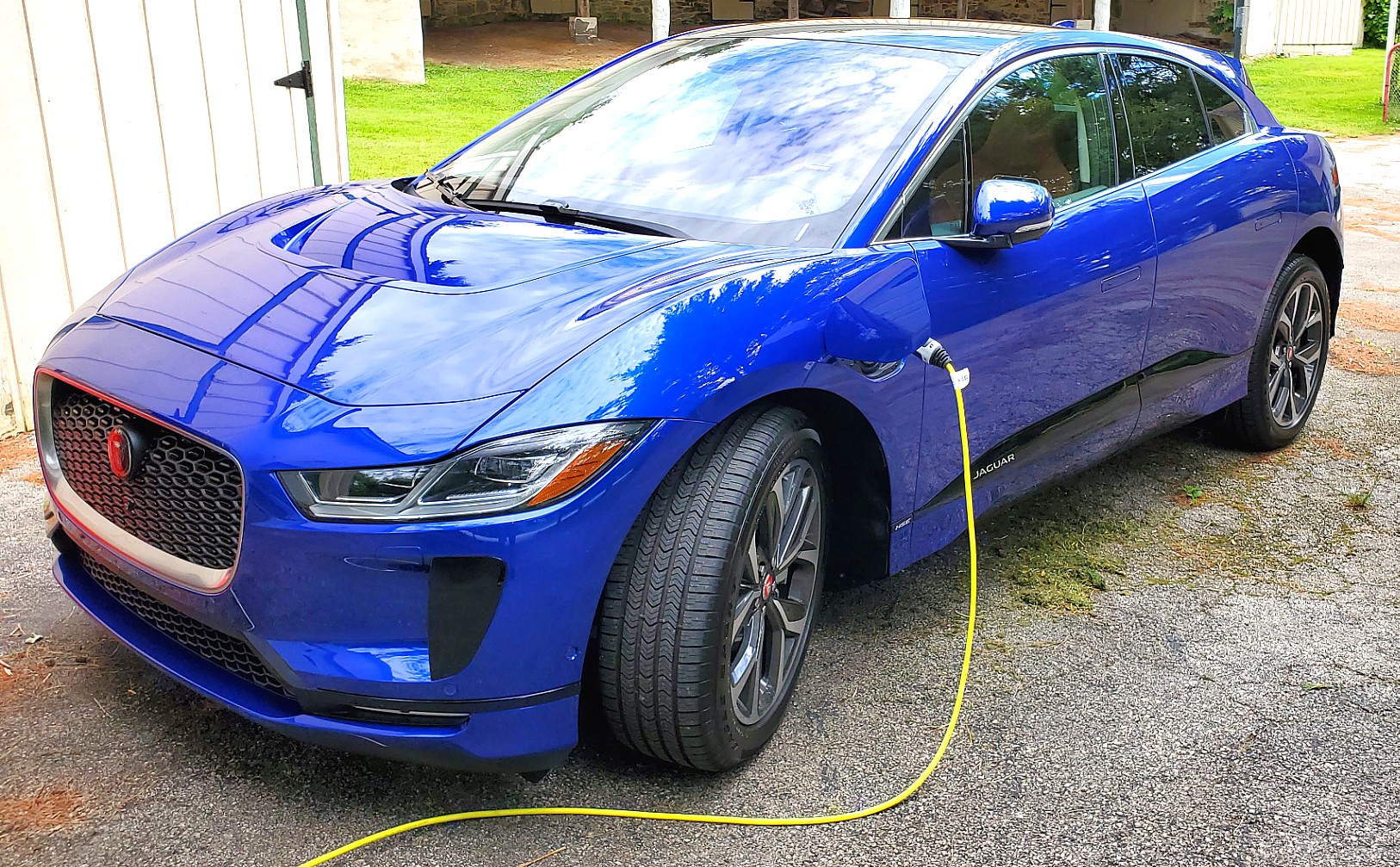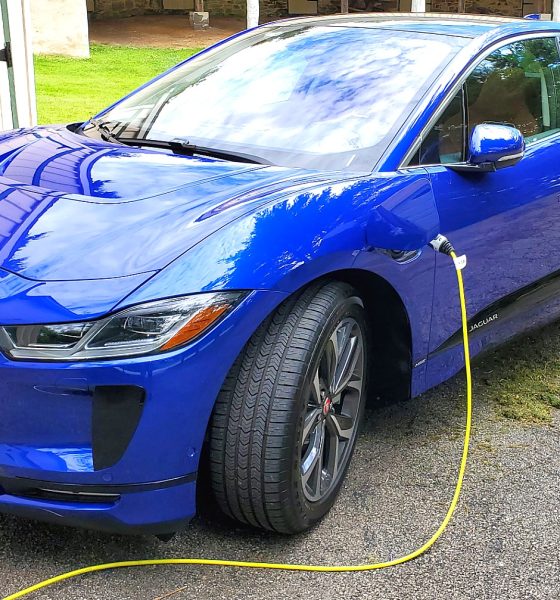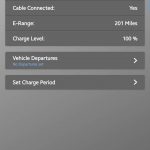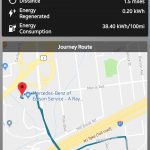

News
Jaguar I-PACE buyer shares ownership experience: range issues, regrets, Teslas, and why EV training matters
Umang Shah is the very definition of a “car guy.” Over his 20 years of car ownership, he has owned 19 vehicles of different styles and brands, from hot hatches to off-road-capable SUVs to high-performance station wagons. This is why, when premium electric cars with decent range and impressive performance started becoming more mainstream, Shah knew that the only question was which electric vehicle he will acquire.
If one were shopping for an electric car, one would likely look at Tesla’s offerings. For Shah, Teslas were incredibly impressive in terms of tech, and the Supercharger Network ensured that range anxiety would be a moot point, but their exterior design was just a bit too conservative. Interestingly, Top Gear host Chris Harris echoed these very same sentiments in a recent review of the Tesla Model 3 Performance.
Thus, after extensive research, Shah opted to purchase a top-of-the-line Jaguar I-PACE for around $90,000. The vehicle was critically acclaimed, having been praised by multitudes of reviewers since its release. It had also been sweeping awards left and right, such as the World Car Design of the Year and World Green Car of the Year awards this past April. The I-PACE was no Tesla in terms of tech, but it had all the accents of a premium automobile from a carmaker like Jaguar, from its luxurious cabin to its bold, aggressive design. Even its range, quoted by the EPA at 234 miles per charge, was decent.

For the I-PACE owner, everything that transpired when he walked into a Jaguar dealership in Edison, NJ, was a perfect example of how hindsight is always 20/20. When he was taking delivery of the vehicle, Shah noticed that the I-PACE was only showing 201 miles of range despite the battery being at 100%. Jaguar informed Shah that the range in the vehicle was “adaptive,” and that it would update over time as the crossover gets driven. Over the next 24 hours, the new EV owner drove his I-PACE, and it quickly became evident that the 201-mile range quoted in the vehicle during delivery might even be optimistic. The surprising scarcity of working fast chargers for the vehicle also tested the I-PACE owner’s patience.
Jaguar left a loaner and took in Shah’s I-PACE for repairs three days after the crossover’s delivery. Based on the I-PACE’s logs from its mobile app, Shah saw that the dealership’s staff charged the vehicle to 100% before going on an 89.5-mile trip, but by the end of the journey, the electric crossover only had 87 miles of range left. A few days after, Shah saw from his mobile app that his I-PACE had been driven for 3.9 miles, which caused a 14-mile drop in the vehicle’s remaining range. Things seemingly took a turn for the better, as the EV owner was informed by the Jaguar dealership a few days later that his crossover had been “patched” with an update related to an ongoing recall for the I-PACE’s brakes, and that it will be ready to be picked up the following day.
The dealership’s staff even added that the I-PACE was already charging in excess of 260-270 miles. Unfortunately, Shah received another call from the dealership right before he was scheduled to reclaim his I-PACE, informing him that the vehicle’s range issues have actually not been addressed. Looking at the crossover’s mobile app, Shah saw that his I-PACE had taken a 1.5-mile trip that ended up consuming 17 miles of range. At this point, the issue was escalated to Jaguar Land Rover corporate, and the I-PACE remained unusable. In a conversation with Teslarati, Shah stated that amidst his vehicle’s issues, it became very evident that Jaguar dealers were simply unprepared to handle an electric car like the I-PACE. They might have a network of dealers across the country, but with very little staff who actually know electric cars inside out, I-PACE owners could end up being left in limbo when issues arise.
Screenshots from the Jaguar I-PACE’s mobile app. (Credit: Umang Shah)
Shah was with his family when Teslarati spoke with him about his experiences with his Jaguar I-PACE, and during our conversation, the new EV owner sounded regretful. Shah sheepishly admitted that he chose the wrong car over a tried-and-tested EV brand like Tesla. With all the headaches he has developed due to his I-PACE’s range issues that Jaguar’s dealers simply can’t seem to fix, Shah stated that he would have been better off had he purchased the conservatively-styled Tesla Model X instead, since the larger SUV’s Long Range variant goes 325 miles per charge for $91,000 before incentives, and it has basic Autopilot as standard.
Shah is currently looking to get a refund for his I-PACE (or at least a replacement unit), and when asked if this experience has discouraged him from EVs as a whole, the car enthusiast stated that his next vehicle will most definitely still be electric. Though this time around, he would make sure that his EV will be a Tesla.
The experiences of Shah hint at one particular problem that could become tricky for veteran automakers amidst their electric vehicle strategies: releasing premium electric cars is one thing, but having a well-trained staff that knows the ins and outs of EVs and their technologies is another. Hopefully, carmakers such as Jaguar could improve in this metric, and other companies dipping their toes in the EV market like Mercedes-Benz, Audi, and Porsche, would adequately prepare their employees and dealers for the upcoming widespread adoption of electric transportation.

News
Tesla refines Full Self-Driving, latest update impresses where it last came up short
We were able to go out and test it pretty extensively on Saturday, and the changes Tesla made from the previous version were incredibly impressive, especially considering it seemed to excel where it last came up short.

Tesla released Full Self-Driving v14.2.1.25 on Friday night to Early Access Program (EAP) members. It came as a surprise, as it was paired with the release of the Holiday Update.
We were able to go out and test it pretty extensively on Saturday, and the changes Tesla made from the previous version were incredibly impressive, especially considering it seemed to excel where it last came up short.
Tesla supplements Holiday Update by sneaking in new Full Self-Driving version
With Tesla Full Self-Driving v14.2.1, there were some serious regressions. Speed Profiles were overtinkered with, causing some modes to behave in a strange manner. Hurry Mode was the most evident, as it refused to go more than 10 MPH over the speed limit on freeways.
It would routinely hold up traffic at this speed, and flipping it into Mad Max mode was sort of over the top. Hurry is what I use most frequently, and it had become somewhat unusable with v14.2.1.
It seemed as if Speed Profiles should be more associated with both passing and lane-changing frequency. Capping speeds does not help as it can impede the flow of traffic. When FSD travels at the speed of other traffic, it is much more effective and less disruptive.
With v14.2.1.25, there were three noticeable changes that improved its performance significantly: Speed Profile refinements, lane change confidence, and Speed Limit recognition.
🚨 Many of you asked us to test highway driving with Tesla Full Self-Driving v14.2.1.25. Here’s what we noticed:
✅ Speed Profiles are significantly improved. Hurry Mode is no longer capped at 10 MPH over the speed limit, and now travels with the flow of traffic. This is much… pic.twitter.com/48ZCGbW0JO
— TESLARATI (@Teslarati) December 13, 2025
Speed Profile Refinement
Speed Profiles have been significantly improved. Hurry Mode is no longer capped at 10 MPH over the speed limit and now travels with the flow of traffic. This is much more comfortable during highway operation, and I was not required to intervene at any point.
With v14.2.1, I was sometimes assisting it with lane changes, and felt it was in the wrong place at the wrong time more frequently than ever before.
However, this was one of the best-performing FSD versions in recent memory, and I really did not have any complaints on the highway. Speed, maneuvering, lane switching, routing, and aggressiveness were all perfect.
Lane Changes
v14.2.1 had a tendency to be a little more timid when changing lanes, which was sort of frustrating at times. When the car decides to change lanes and turn on its signal, it needs to pull the trigger and change lanes.
It also changed lanes at extremely unnecessary times, which was a real frustration.
There were no issues today on v14.2.1.25; lane changes were super confident, executed at the correct time, and in the correct fashion. It made good decisions on when to get into the right lane when proceeding toward its exit.
It was one of the first times in a while that I did not feel as if I needed to nudge it to change lanes. I was very impressed.
Speed Limit Recognition
So, this is a complex issue. With v14.2.1, there were many times when it would see a Speed Limit sign that was not meant for the car (one catered for tractor trailers, for example) or even a route sign, and it would incorrectly adjust the speed. It did this on the highway several times, mistaking a Route 30 sign for a 30 MPH sign, then beginning to decelerate from 55 MPH to 30 MPH on the highway.
This required an intervention. I also had an issue leaving a drive-thru Christmas lights display, where the owners of the private property had a 15 MPH sign posted nearly every 200 yards for about a mile and a half.
The car identified it as a 55 MPH sign and sped up significantly. This caused an intervention, and I had to drive manually.
It seems like FSD v14.2.1.25 is now less reliant on the signage (maybe because it was incorrectly labeling it) and more reliant on map data or the behavior of nearby traffic.
A good example was on the highway today: despite the car reading that Route 30 sign and the Speed Limit sign on the center screen reading 30 MPH, the car did not decelerate. It continued at the same speed, but I’m not sure if that’s because of traffic or map data:
🚨 We listened to and read a lot of you who had a complaint of Tesla Full Self-Driving v14.2.1 incorrectly reading Speed Limit signs
This appears to be resolved in v14.2.1.25.
Here’s a breakdown: pic.twitter.com/TEP03xrMbt
— TESLARATI (@Teslarati) December 13, 2025
A Lone Complaint
Tesla has said future updates will include parking improvements, and I’m really anxious for them, because parking is not great. I’ve had some real issues with it over the past couple of months.
Today was no different:
🚨 My lone complaint with my drive on Tesla FSD v14.2.1.25 was this strange parking instance.
FSD swung out wide to the left to pull into this spot and this is where it seemed to be stumped. I gave it about 10 seconds after the car just stopped moving for it to make some… https://t.co/ZEkhTHOihG pic.twitter.com/TRemXu5DLf
— TESLARATI (@Teslarati) December 13, 2025
Full Self-Driving v14.2.1.25 is really a massive improvement over past versions, and it seems apparent that Tesla took its time with fixing the bugs, especially with highway operation on v14.2.1.
News
Tesla hints at Starlink integration with recent patent
“By employing polymer blends, some examples enable RF transmission from all the modules to satellites and other communication devices both inside and outside the vehicle.”

Tesla hinted at a potential Starlink internet terminal integration within its vehicles in a recent patent, which describes a vehicle roof assembly with integrated radio frequency (RF) transparency.
The patent, which is Pub. No U.S. 2025/0368267 describes a new vehicle roof that is made of RF-transparent polymer materials, allowing and “facilitating clear communication with external devices and satellites.”
Tesla believes that a new vehicle roof design, comprised of different materials than the standard metallic or glass elements used in cars today, would allow the company to integrate modern vehicular technologies, “particularly those requiring radio frequency transmission and reception.
Tesla has recently filed a US patent application on integrating RF transparent materials into the roof structure.
“facilitating clear communication with external devices and satellites”
Tesla fleet is getting @Starlink connectivity integration soon. LFG @Tesla @elonmusk… pic.twitter.com/bLa8YtPLd1
— Chansoo Byeon (@Chansoo) December 9, 2025
Instead of glass or metallic materials, Tesla says vehicles may benefit from high-strength polymer blends, such as Polycarbonate, Acrylonitrile Butadiene Styrene, or Acrylonitrile Styrene Acrylate.
These materials still provide ideal strength metrics for crashworthiness, stiffness for noise, vibration, and harshness control, and are compliant with head impact regulations.
They would also enable better performance with modern technologies, like internet terminals, which need an uninterrupted signal to satellites for maximum reception. Tesla writes in the patent:
“By employing polymer blends, some examples enable RF transmission from all the modules to satellites and other communication devices both inside and outside the vehicle.”

One of the challenges Tesla seems to be aware of with this type of roof design is the fact that it will still have to enable safety and keep that at the forefront of the design. As you can see in the illustration above, Tesla plans to use four layers to increase safety and rigidity, while also combating noise and vibration.
It notes in the patent that disclosed examples still meet the safety requirements outlined in the Federal Motor Vehicle Safety Standards (FMVSS).
Starlink integrated directly into Tesla vehicles would be a considerable advantage for owners. It would come with a handful of distinct advantages.
Initially, the inclusion of Starlink would completely eliminate cellular dead zones, something that is an issue, especially in rural areas. Starlink would provide connectivity in these remote regions and would ensure uninterrupted service during road trips and off-grid adventures.
It could also be a critical addition for Robotaxi, as it is crucial to have solid and reliable connectivity for remote monitoring and fleet management.
Starlink’s growing constellation, thanks to SpaceX’s routine and frequent launch schedule, will provide secure, stable, and reliable internet connectivity for Tesla vehicles.
Although many owners have already mounted Starlink Mini dishes under their glass roofs for a similar experience, it may be integrated directly into Teslas in the coming years, either as an upgrade or a standard feature.
News
Tesla supplements Holiday Update by sneaking in new Full Self-Driving version
It seems Tesla was waiting for the Hardware 4 rollout, as it wanted to also deploy a new Full Self-Driving version to those owners, as it appeared in the release notes for the Holiday Update last night.

Tesla has surprised some owners by sneaking in a new Full Self-Driving version with the wide release of the Holiday Update, which started rolling out to Hardware 4 owners on Friday night.
Tesla has issued a controlled and very slow release pattern with the Holiday Update, which rolls out with Software Version 2025.44.25.5.
For the past two weeks, as it has rolled out to Hardware 3 and older Tesla owners, the company has kept its deployment of the new Software Version relatively controlled.
It seems Tesla was waiting for the Hardware 4 rollout, as it wanted to also deploy a new Full Self-Driving version to those owners, as it appeared in the release notes for the Holiday Update last night.
Tesla Full Self-Driving v14.2.1.25 made its first appearance last night to Hardware 4 owners who are members of the Early Access Program (EAP). It appears to be a slight refinement from FSD v14.2.1, which has been out for a couple of weeks.
Tesla v2025.44.25.5 Holiday update incoming
Also Full Self-Driving v14.2.1.25!!! pic.twitter.com/74D7S0UGXz
— TESLARATI (@Teslarati) December 13, 2025
Many owners welcome the new FSD version, us included, because we’ve been less than impressed with v14.2.1. We have experienced some minor regressions with v14.2.1, especially with Speed Limit recognition, Speed Profile tinkering, and parking performance.
As it stands, Full Self-Driving is still particularly impressive, but Tesla is evidently having an issue with some of the adjustments, as it is still refining some of the performance aspects of the suite. This is expected and normal with some updates, as not all of them are an improvement in all areas; we routinely see some things backtrack every once in a while.
This new FSD version is likely to take care of those things, but it also includes all of the awesome Holiday Update features, which include:
- Grok with Navigation Commands (Beta) – Grok will now add and edit destinations.
- Tesla Photobooth – Take pictures inside your car using the cabin-facing camera
- Dog Mode Live Activity – Check on your four-legged friend on your phone through periodic snapshots taken of the cabin
- Dashcam Viewer Update – Includes new metrics, like steering wheel angle, speed, and more
- Santa Mode – New graphics, trees, and a lock chime
- Light Show Update – Addition of Jingle Rush light show
- Custom Wraps and License Plates – Colorizer now allows you to customize your vehicle even further, with custom patterns, license plates, and tint
- Navigation Improvements – Easier layout and setup
- Supercharger Site Map – Starting at 18 pilot locations, a 3D view of the Supercharger you’re visiting will be available
- Automatic Carpool Lane Routing – Navigation will utilize carpool lanes if enabled
- Phone Left Behind Chime – Your car will now tell you if you left a phone inside
- Charge Limit Per Location – Set a charge limit for each location
- ISS Docking Simulator – New game
- Additional Improvements – Turn off wireless charging pad, Spotify improvements, Rainbow Rave Cave, Lock Sound TRON addition
Tesla also added two other things that were undocumented, like Charging Passport and information on USB drive storage to help with Dashcam.











